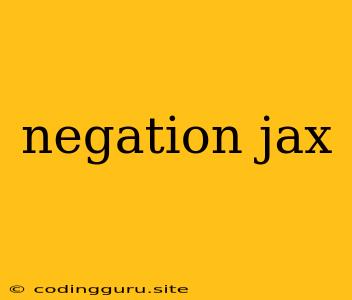Negation in JAX: A Deep Dive
JAX, a high-performance numerical computation library, offers powerful tools for manipulating and transforming arrays. One fundamental operation in any numerical computation is negation, flipping the sign of a value. Understanding negation in JAX is essential for building complex numerical models and algorithms.
What is Negation in JAX?
Negation in JAX, like in other programming languages, is the process of inverting the sign of a number. This means that a positive number becomes negative, and a negative number becomes positive. In JAX, negation is achieved through the - operator.
How to Use Negation in JAX
The simplest way to apply negation in JAX is by using the unary - operator:
import jax.numpy as jnp
x = jnp.array([1, -2, 3])
negated_x = -x
print(negated_x) # Output: [-1 2 -3]
In this example, we first create a JAX array x containing numbers 1, -2, and 3. Then, we apply the - operator to x, resulting in a new array negated_x with the signs of each element flipped.
Beyond Simple Negation: JAX's Flexibility
While the basic - operator works for simple negation, JAX offers more sophisticated ways to handle negation:
- Broadcasting: JAX supports negation for arrays with different shapes. For example, if you subtract a scalar from an array, the scalar is broadcasted across the array's elements.
- Advanced Operations: You can combine negation with other JAX operations like element-wise multiplication or addition. This allows for complex calculations while still taking advantage of JAX's speed and efficiency.
- Custom Functions: You can even create your own custom functions that perform negation with additional logic or constraints.
Benefits of Using Negation in JAX
Using negation in JAX offers several advantages:
- Efficiency: JAX performs negation operations on arrays at a high speed due to its optimized backend and just-in-time compilation.
- Flexibility: JAX's broadcasting and other features make it easy to work with negation for various array shapes and operations.
- Integrability: Negation seamlessly integrates with other JAX operations and libraries, allowing you to build complex mathematical models with ease.
Common Use Cases of Negation in JAX
Negation in JAX finds applications in diverse areas of numerical computation, including:
- Linear Algebra: Negation plays a crucial role in matrix operations like finding inverses and solving linear systems.
- Optimization: Negation is often used to transform objective functions or constraints in optimization algorithms.
- Machine Learning: Negation is used in various machine learning tasks, such as implementing activation functions or performing gradient descent.
Conclusion
Negation is a fundamental operation in JAX that enables efficient manipulation of numerical data. JAX offers a flexible and performant approach to applying negation for various array shapes and operations. Its seamless integration with other JAX functionalities empowers you to build complex numerical models and algorithms with ease. By mastering the power of negation in JAX, you can unlock new possibilities in your numerical computations.
